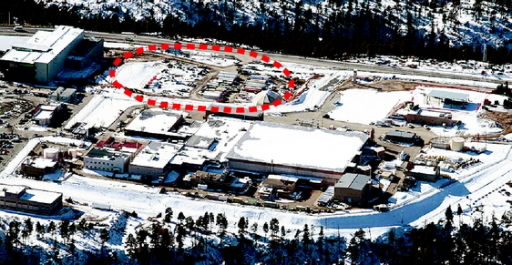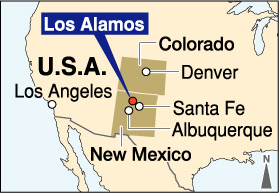Nuclear weapons can be eliminated: Chapter 1, Part 3
Mar. 13, 2009
Chapter 1: Superpower at a turning point
Part 3: Los Alamos
by Yumi Kanazaki, Staff Writer
Opponents hope plans for new nuclear development site will be abandoned
The Los Alamos National Laboratory is located in the southwestern state of New Mexico on a plateau at the southern reaches of the Rocky Mountains. The facility can be reached by a 10-minute flight by light plane from the capital city of Santa Fe. The day I went there it was covered with a light dusting of snow.
It was there that the atomic bombs that were dropped on Hiroshima and Nagasaki, mankind’s first nuclear weapons, were developed and manufactured during World War II as part of the Manhattan Project.
As we flew over the Rio Grande River and approached the laboratory, through my headphones I heard the deep voice of fellow passenger Scott Kovac as he pointed to one area of the lab’s grounds. “That’s where they’re planning to build the new facility. It’s one of the sites the U.S. says is necessary for manufacturing plutonium pits.” Mr. Kovac, 52, is a member of a local watchdog organization, Nuclear Watch New Mexico, that monitors the lab’s activities.
Plutonium pits are the core of nuclear warheads. They were previously manufactured at the Rocky Flats plant near Denver, Colorado, but plutonium production at the facility was halted in 1989 because of environmental problems. The new facility at Los Alamos will replace Rocky Flats. It will be designed to manufacture up to 80 pits per year, and the cost of construction is expected to exceed ¥250 billion ($2.5 billion). The project is part of a plan to realign the nation’s nuclear weapons facilities.
Will President Barack Obama, who has said he will work to achieve a world without nuclear weapons, change the plan to manufacture plutonium pits?
Peter Neils, 60, president of the Los Alamos Study Group, a local watchdog group, discussed the issue in Albuquerque, New Mexico’s largest city. “This was originally part of a plan to develop new nuclear weapons. It’s related to the reliable replacement warhead plan, which is currently a matter of concern.”
The administration of former President George W. Bush promoted RRW, saying that warheads manufactured during the Cold War had a life span of only 20 years and that in order to maintain reliability they must be replaced, which essentially involves the development of new nuclear weapons. In the fall of 2006, however, some nuclear physicists and other experts released findings that concluded that the actual life span of the pits is approximately 100 years. As a result, Congress cut all funding for the project from the budget in both fiscal 2008 and 2009, dealing a major setback to the RRW plan.
But in October 2008 Secretary of Defense Robert Gates said that the U.S. should develop RRW or it will be forced to resume nuclear testing to ensure the reliability of the nuclear stockpile--something it has not done since 1992. Mr. Gates is a holdover from the Bush administration.
President Obama has expressed support for ratification of the Comprehensive Nuclear Test Ban Treaty and has clearly rejected the development of new nuclear weapons, but his retention of Mr. Gates may lead to discord within the Cabinet. Mr. Neils and his group noted that the construction of the plutonium pit manufacturing facility is in its early stages and there is still time to halt the project. They expressed the hope that the president will exercise his leadership to do so.
(Originally published on February 13, 2009)
To comment on this article, please click the link below. Comments will be moderated and posted in a timely fashion. Comments may also appear in the Chugoku Shimbun newspaper.









